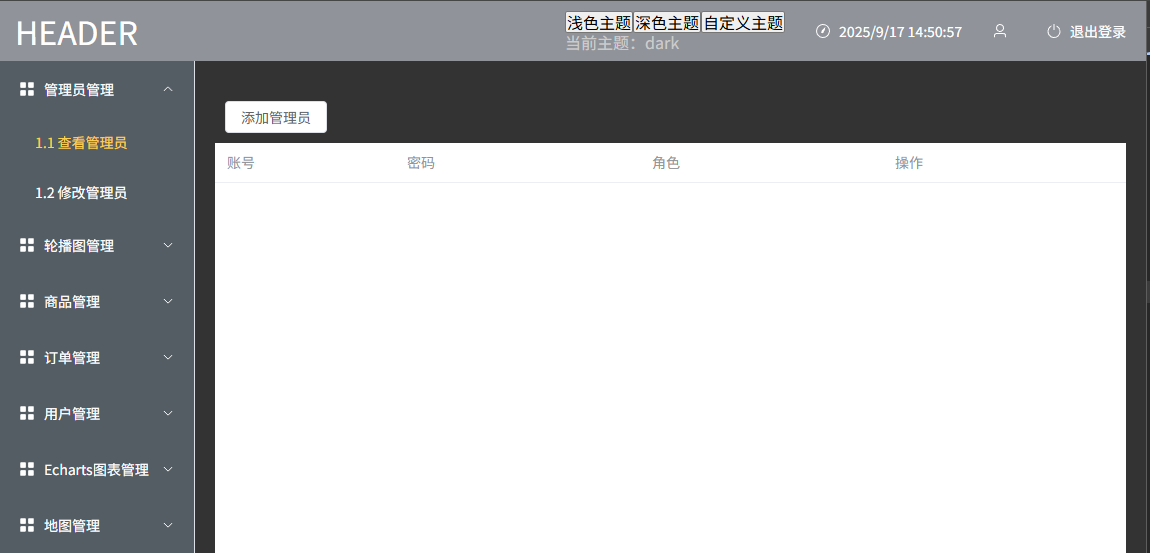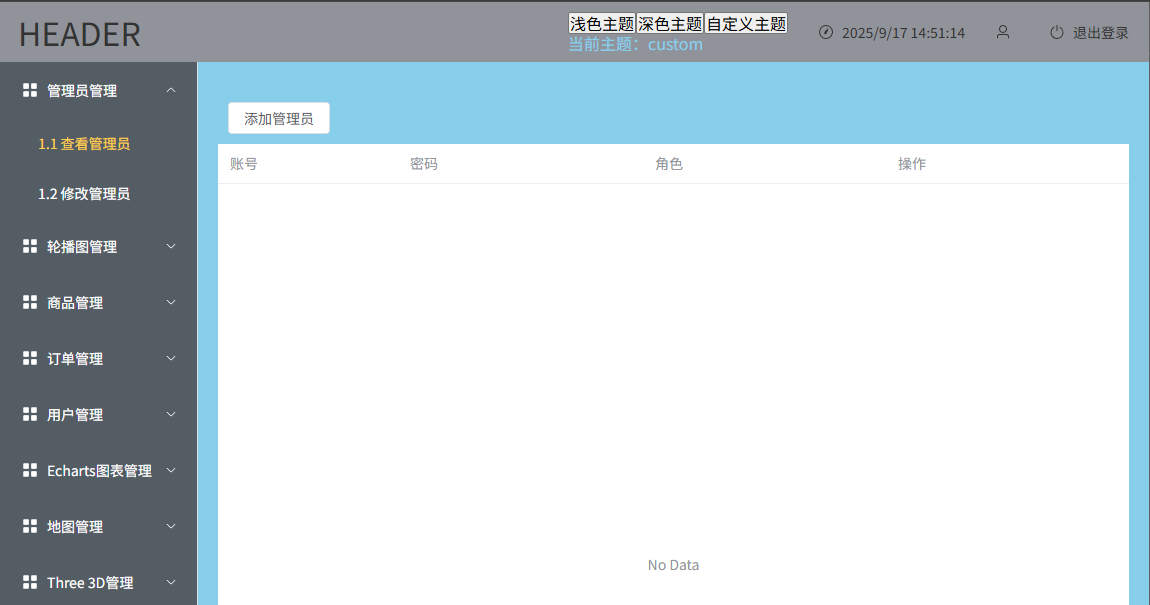Vue 项目主题切换功能实现:两种方案详解与选型分析
在现代前端项目开发中,主题切换已成为提升用户体验的核心功能之一 —— 无论是适配用户白天 / 夜间的使用场景、满足企业级产品的品牌定制需求,还是应对不同设备的显示环境,灵活的主题系统都能让产品更具竞争力。在 Vue 3 项目中,基于 CSS 变量与组合式 API(Composables)的主题切换方案最为常见,以下将详细拆解两种实现思路,并结合实际项目需求分析选型逻辑。
方案一:基于 CSS 类名切换的主题系统
该方案的核心思路是通过预定义不同主题的 CSS 类(如.theme-dark),在切换时为根元素添加 / 移除对应类名,触发全局 CSS 变量的替换,适合主题样式固定、扩展需求较少的中小型项目。
步骤 1:搭建全局样式文件结构
首先在/src/assets下新建styles文件夹并创建theme.scss文件 —— 选择 SCSS 而非普通 CSS,是因为 SCSS 支持变量嵌套、混入等特性,后续若需扩展主题样式(如添加主题专属组件样式),可更高效地维护。

theme.scss文件:
// 默认使用浅色主题
:root{--bg-color:#ffffff;--text-color: #333333;
}// 深色主题
.theme-dark{--bg-color:#333333;--text-color: #ffffff;
}// 自定义主题
.theme-custom{ --bg-color: red;--text-color: #333333;
}// 全局应用背景色
body{background-color: var(--bg-color);color: var(--text-color);transition: background-color 0.5s ease-in-out; // 添加过渡效果,平滑过渡
}步骤 2:全局导入样式文件
在 Vue 入口文件main.ts中导入theme.scss—— 入口文件导入可确保样式全局生效,无需在每个组件中重复引入,避免代码冗余。同时,该步骤需在createApp之前执行,确保组件渲染时主题样式已加载。
import './assets/main.css'
import { createApp } from 'vue'
import { createPinia } from 'pinia'
import App from './App.vue'
import router from './router'
import './assets/styles/theme.scss'; // 导入全局主题样式:确保主题变量全局可访问const app = createApp(App)app.use(createPinia())
app.use(router)app.mount('#app')步骤 3:在头部组件实现主题切换交互
头部组件是用户高频操作区域,在此添加主题切换按钮可提升易用性。核心逻辑是通过useTheme组合式 API 封装主题切换方法,同时结合 Pinia 存储用户信息、定时器更新当前时间,确保功能模块化。
<script lang="ts" setup>
import router from '@/router';
import { ref, onMounted, watchEffect, computed, onUnmounted } from 'vue'
import type { Ref } from 'vue'
import { getUserInfo } from '@/api/home';
import { useUserStore } from '@/stores/user';
import { useTheme } from '@/composables/useTheme';const { currentTheme, changeTheme } = useTheme();const userStore = useUserStore()interface IUserInfo {adminid: string,adminname: string,checkedKeys: any[],role: number
}
const userInfo: Ref<IUserInfo> = ref({adminid: '',adminname: '',checkedKeys: [],role: -1
})// 1.使用 ref 创建一个响应式的当前时间 toLocaleString()是格式化日期和时间的方法
const currentTime = ref(new Date().toLocaleString())
// 2.定义一个函数来更新时间
function updateTime(){currentTime.value = new Date().toLocaleString()
}onMounted(async () => {// 3.设置一个定时器,每一秒更新一遍时间const time = setInterval(updateTime,1000)onUnmounted(()=>{// 4.在组件卸载时清除定时器,避免内存泄漏clearInterval(time)})const res = await getUserInfo({adminname: userStore.userInfo.adminname})userInfo.value = res.data.data[0]
})const logout = (() => {localStorage.removeItem('userInfo')router.replace('/login')
})
</script>
<template><div class="header-manage"><h1>HEADER</h1><div class="admin-manage"><div class="theme-switch"><button @click="changeTheme('light')">浅色主题</button><button @click="changeTheme('dark')">深色主题</button><button @click="changeTheme('custom')">自定义主题</button><p class="theme-text">当前主题:{{ currentTheme }}</p></div><div class="admin-con"><el-icon><i-ep-Stopwatch /></el-icon><span>{{ currentTime }}</span></div><div class="admin-con"><el-icon><i-ep-User /></el-icon><span>{{ userStore.userInfo.adminname }}</span></div><div class="admin-con" style="cursor: pointer;"><el-icon><i-ep-SwitchButton /></el-icon><span @click="logout">退出登录</span></div></div></div>
</template>
<style lang="scss" scoped>
.header-manage {width: 100%;height: 100%;display: flex;justify-content: space-between;align-items: center;color:var(--text-primary-color) //全局主题颜色
}.admin-manage {display: flex;.theme-switch { .theme-text{color: var(--text-secondary-color);}}
}.admin-con {margin-left: 30px;display: flex;align-items: center;span {font-size: 14px;margin-left: 8px;}
}
</style>方案二:基于 TypeScript 配置的动态主题系统
该方案的核心思路是通过 TypeScript 定义主题配置接口,将主题变量集中管理,切换时直接通过 JS 动态修改根元素的 CSS 变量,无需预定义 CSS 类,灵活性更高,适合主题变量多、需频繁扩展的中大型项目。
1. 步骤 1:搭建主题配置文件
在/src下新建theme文件夹并创建index.ts—— 用 TypeScript 定义主题接口与配置,既能通过类型约束避免变量名错误,又能将所有主题变量集中管理,后续修改或新增主题时,只需更新配置文件即可。
// 主题配置接口(添加索引签名)
interface ThemeConfig {"--bg-color": string;"--text-primary-color": string;"--text-secondary-color": string;"--text-tertiary-color": string;"--text-disabled-color": string;"--button-bg-color": string;"--button-text-color": string;// 索引签名:允许用字符串键访问(关键!)[key: string]: string;
}// 主题类型定义
export type ThemeType = 'light' | 'dark' | 'custom'// 主题配置
export const themeConfig: Record<ThemeType, ThemeConfig> = {light:{"--bg-color":'#ffffff', // 背景色"--text-primary-color": '#333333',// 主要文字色"--text-secondary-color":'#666666', // 次要文字色"--text-tertiary-color":'#999999', // 三级文字色"--text-disabled-color":'#cccccc', // 禁用文字色"--button-bg-color":'#42b983', // 按钮背景色"--button-text-color":'#ffffff', // 按钮文字色},dark:{"--bg-color":'#333333', // 背景色"--text-primary-color":'#ffffff', // 主要文字色"--text-secondary-color":'#cccccc', // 次要文字色"--text-tertiary-color":'#999999', // 三级文字色"--text-disabled-color":'#666666', // 禁用文字色"--button-bg-color":'#42b983', // 按钮背景色"--button-text-color":'#ffffff', // 按钮文字色},custom:{"--bg-color":'skyblue', // 背景色"--text-primary-color":'#333333', // 主要文字色"--text-secondary-color":'skyblue', // 次要文字色"--text-tertiary-color":'#999999', // 三级文字色"--text-disabled-color":'#cccccc', // 禁用文字色"--button-bg-color":'#42b983', // 按钮背景色"--button-text-color":'#ffffff', // 按钮文字色}
}// 默认主题
export const defaultTheme: ThemeType = 'light';步骤 2:封装主题切换组合式 API
在/src/composables下新建useTheme.ts—— 用 Vue 的组合式 API 封装主题切换逻辑,将 “主题初始化、主题应用、主题切换” 等功能模块化,后续任何组件需要使用主题功能,只需导入该 API 即可,避免代码重复。
import type { ThemeType } from '@/theme'
import { themeConfig, defaultTheme } from '@/theme'
import { onMounted, ref } from 'vue'export function useTheme() { // 当前主题,响应式const currentTheme = ref<ThemeType>(defaultTheme)// 初始化:从localStorage中获取保存的主题onMounted(() => {const theme = localStorage.getItem('app-theme') as ThemeTypeif (theme && Object.keys(themeConfig).includes(theme)) {currentTheme.value = themeapplyTheme(theme) //应用主题}})// 应用主题(核心:给html加主题类名,触发css变量切换)const applyTheme = (theme: ThemeType) => {// 先移除所有主题类document.documentElement.classList.remove('theme-light','theme-dark','theme-custom')// 添加当前主题类(如果不是默认主题)// if(theme !== 'light'){// document.documentElement.classList.add(`theme-${theme}`)// }Object.keys(themeConfig[theme]).forEach(key => {document.documentElement.style.setProperty(`${key}`, themeConfig[theme][key]);});// document.documentElement.style.setProperty('--bg-color', themeConfig[theme].backgroundColor);// 存储当前主题localStorage.setItem('app-theme', theme)}// 切换主题const changeTheme = (theme: ThemeType) => {if(themeConfig[theme]){currentTheme.value = themeapplyTheme(theme)}}return { currentTheme, changeTheme }
}步骤 3:复用组件交互逻辑
与方案一的步骤 3 一致,在头部组件中导入useTheme API,绑定按钮点击事件触发changeTheme—— 由于方案二的主题逻辑已通过 API 封装,组件层面无需修改任何交互代码,只需复用现有按钮即可实现主题切换,体现了模块化的优势。



三、两种方案对比与选型分析
| 对比维度 | 方案一(CSS 类名切换) | 方案二(TS 配置动态修改) |
|---|---|---|
| 实现原理 | 预定义主题类,通过添加 / 移除类名切换 | 集中管理 TS 配置,动态修改 CSS 变量 |
| 灵活性 | 新增主题需修改 CSS 文件,扩展成本高 | 新增主题只需添加 TS 配置,扩展成本低 |
| TypeScript 支持 | 无类型约束,易出现变量名错误 | 接口 + 类型约束,避免变量错误 |
| 维护成本 | 主题样式分散在 CSS 中,维护难度高 | 主题配置集中在 TS 中,维护更高效 |
| 持久化实现 | 需额外编写逻辑保存类名 | 内置 localStorage 保存,逻辑更简洁 |
| 适用场景 | 主题少、需求稳定的中小型项目 | 主题多、需频繁扩展的中大型项目 |
从实际项目需求出发,方案二的优势更为明显:一是 TypeScript 的类型约束降低了协作中的错误率;二是集中式配置让主题维护更高效(如后续新增 “企业主题”,只需在themeConfig中添加配置);三是动态修改 CSS 变量无需预定义类名,减少了 CSS 代码冗余。因此,最终选择方案二作为项目的主题切换实现方案。
